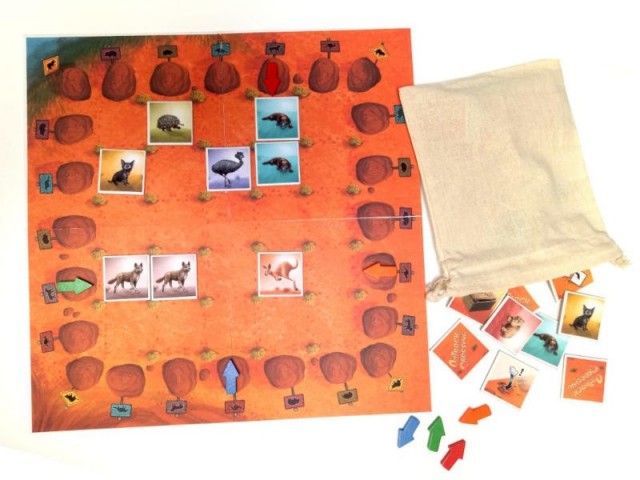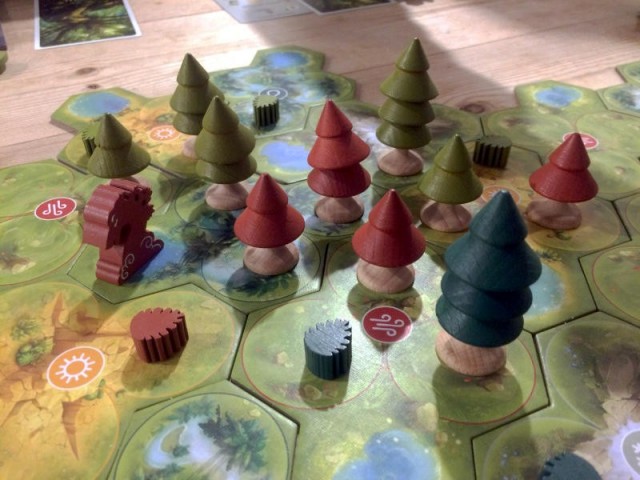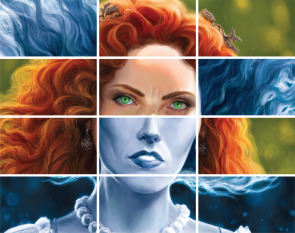Jim Felli returns with yet another stunning, singular design.
In board games, the board itself is often a map or another representation of geographic or spatial proximity. Sometimes it is an array of containers or trackers that indicate holdings, timers, or other game state information. It can abstract an entire continent or universe. But how many games have you played where the board – the medium where you engage the other player – is a woman’s face?
This is a review of a game by James Felli called “The Mirroring of Mary King” and if you have any experience with this designer’s games, you may not be all that surprised that it is an experience quite unlike anything else out there. This game is a ghost story wherein Mary King encounters a vengeful, ancestral spirit in a Scottish castle that seeks to possess her mind, body, and soul. One player is Mary King, the other is the ghost. And the battlefield is the portrait of a woman that shifts in and out of focus, in and out of corporeality, as the spirit tries to claim her.
If you aren’t already interested in the wholly unique place where this game is going to take you, if you’re overly worried about “replayability”, whether the box fits the cards when sleeved, or if it’s all properly “balanced” then fuck right on off to Kickstarter where I am sure there are plenty of games to service you. But if you want to stick around, I’ll tell you why this game is special.
It’s not because of the mechanics, which are great but to be honest aren’t why I’m so impressed with this game. I’m not even going to spend much time in enumerating them. I’m sure other commenters and armchair critics will do so elsewhere in their “buy or try” analyses. Suffice to say that this is an excellent two player card game that elevates mundane gameplay concepts such as hand management and area control to a transcendental height by virtue of its subject matter. It’s tense, with plenty of back-and-forth play, sudden breakthroughs, and sudden reversals of position. It’s brief, running on a day-based timer that clocks out well before interest levels in the mechanisms and process wane.
What makes it special is that it is always about Mary King.
The focus of the game is in flipping the tiles that comprise her portrait in an attempt to control larger areas of her psyche, thus reducing options for the other player until eventually one side collapses. As the game progresses, these tiles go from naturally colorful and bright to ethereally bleak and monochrome. Her hair flies wild, her green eyes bleach to white and then back again. But it happens in pieces, sometimes chunks, and the effect is like watching this internal, psychological and spiritual struggle unfold. Sometimes one side will appear to have the advantage, but then an Idea card shifts the entire situation.
Watching this happen is strangely, unexpectedly moving. Because this game is about Mary King, and it’s actually about something other than capitalist fantasies, dredging up the old justifications for colonialism, or passive aggressively out-drafting a nominal array of nominal opponents. It’s about this woman, and the entire game you are looking her in the eyes and she changes over the course of a week. It’s not hard to view this game as a metaphor for mental struggle, for trying to hold it together when sadness, regret, misery, or loss threatens to overwhelm us. Or it could be about simply wanting to exist, to assert ourselves into the present and establish a future. We can see ourselves in that picture of Mary King as we play cards to affect her internal struggle.
But in this struggle, there is a duality acknowledged- this is a game about “mirroring”, and it is about two Mary Kings. Maybe you can flip all the tiles over and become one or the other, a victory condition for the mortal or the immortal. But even if you do that, the other Mary King is also complete on the reverse of the tiles, unseen and separated by a thin barrier of cardboard. We can fight the ghost or become it, but it was us and is still us, on the inverse.
This is what theme is – not flavor text, not miniatures, not pictures of Marvel superheroes or Star Wars spaceships. This is a game about something, that makes a statement about something that can resonate with us . Few designers are, if we are being honest, capable of achieving this kind of design goal. The Mirroring of Mary King has a narrative, and that narrative speaks to us about the struggle to realize one’s self while coming to terms with and sublimating the influence of the past, of negative energies starved for emergence and to be noticed in our continuing lives. In many ways, this is game is the closest any has come to true gothic horror.
Mr. Felli’s games are always singular, always compelling, and always idiosyncratic and this one is no exception. You’ve not played a game like this before. I’m sure some will break it down to a fucking boring litany of Boardgamegeek-isms, their critical frame of reference based on a comment some guy posted in his 6.5 rating. Others won’t be touched or moved by the themes at play here and how they interact with player agency, decision, and resolution. Maybe some players just won’t get it and still others won’t recognize that games can be more than just a fun pastime.This is definitely an arthouse game and not one stuffed to the gills with crowd-pleasing scenarios, pointless variations, and scads of bits. It’s a small, modest game with huge ambition that dwarfs every single five-million-dollar Kickstarter game you’ve ever pledged for.
It’s not my favorite game ever. It’s not the first game I’m going to reach for when it’s just my daughter or my son and I. I have friends that I wouldn’t even think of introducing it to, I just don't think they'd appreciate it. I’m not even sure that it’s one I want to play more than a handful of times because it’s such a precious, fragile experience that I’m afraid to dilute its value with routine. It slots in with a very, very rare subset of games that have completely changed the way I think about board game design and criticism in just a few plays. Shadows of Malice, another Felli joint, was another. I think about that game all the time and I expect to think about The Mirroring of Mary King for many years to come even if I never play it again.
This is a game where you spend the entire duration looking into the eyes of a woman while she fights against herself to achieve self-realization, right there on the table. Mary King is the landscape; the interior territories of heart, mind, and soul are the battlegrounds. That is such an impactful thing, and after so many artless “just fine” and “competent” designs over the past decade or so of board game design it’s unspeakably reinvigorating to encounter a game this daring, bold, and introspective from one of the most talented and courageous designers working today.
 Games
Games How to resolve AdBlock issue?
How to resolve AdBlock issue? 


























